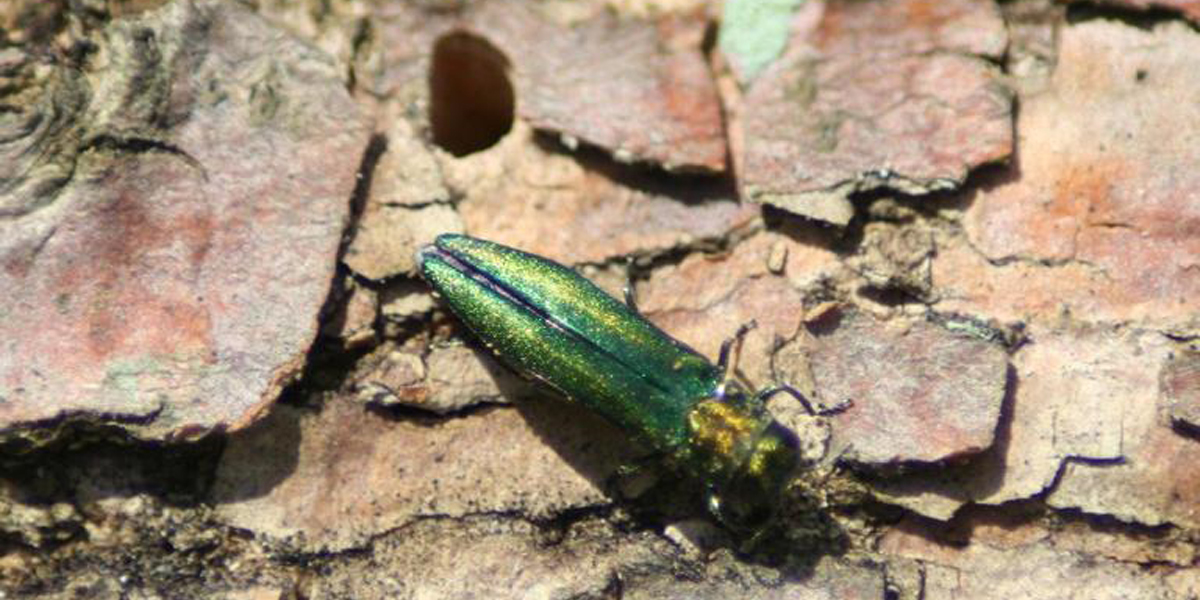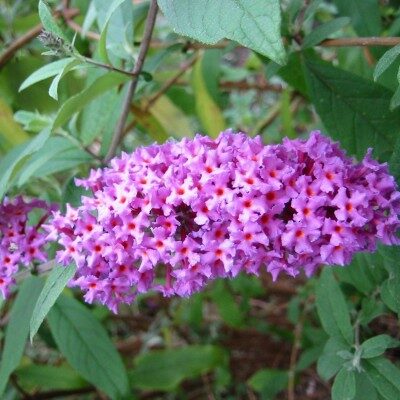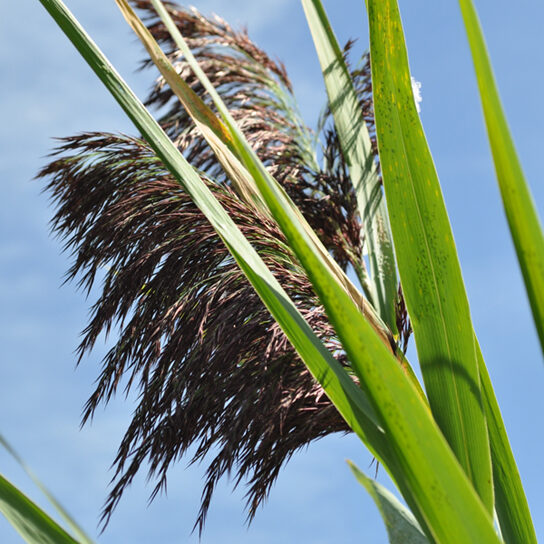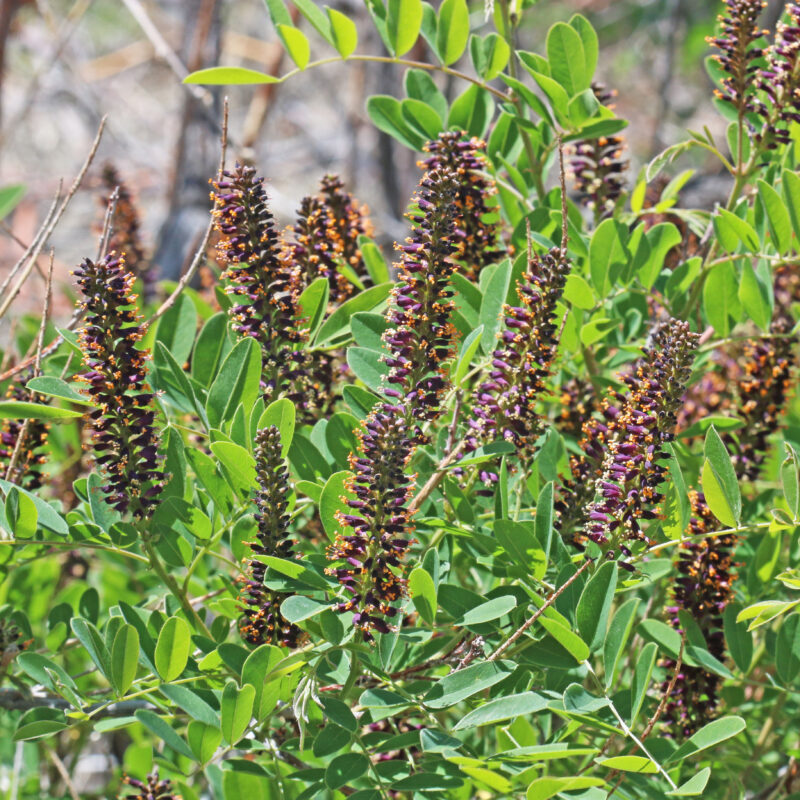Emerald ash borer (EAB) is considered the most destructive forest pest in North America and can kill all species of ash trees. In the greater Portland area and throughout the Willamette Valley, native Oregon ash (Fraxinus latifolia) is of particular concern in our region. This tree is critically important for forested wetlands and riparian areasRiparian areas The land alongside a stream, creek, river, or floodplain. For some ash-dominated wetlands, there is no native canopy-forming tree that grows in the same conditions.
Lifecycle
Adult beetles lay their eggs inside ash trees. The larvae feed on the tissue below the bark, slowly killing the tree. Larvae pupate into adult beetles inside the tree and bore their way out through the bark. Adults then feed on the leaves of host trees.
Most females lay their eggs on trees within 100 yards of where they emerged but can disperse up to 2 to 3 miles. Therefore, ash trees within 30 miles of an infestation are considered at risk. It can take 4 to 6 years for an infested tree to die, and there may be no noticeable effects for the first few years.
Impact
The insect is native to northeast Asia and was unintentionally introduced to the U.S. likely in ash wood used in cargo shipping. It was first detected in Michigan in 2002 and has since spread to 36 states and 5 Canadian provinces. It was discovered in Oregon in 2022. EAB has spread from people moving firewood, logs, or ash trees from nurseries, as well as by the natural movement of the insect.
What you can do
Prevent new introductions: If you use firewood, buy and use firewood locally (within 10 miles of harvest location) and transport only firewood that has been heat-treated and certified as pest-free. Transport of firewood and nursery stock are the major pathways for the spread of this destructive beetle.
Slow the spread:
Learn to recognize ash trees and map any ash trees you find on iNaturalist.
Look for the following signs of poor tree health and symptoms of emerald ash borer infestation:
- Dead or dying ash trees or branches, particularly high up in the canopy, where the adult beetles typically start their feeding and laying of eggs. Tree die-back can be subtle at first, so it’s important to look closely.
- Epicormic branching — branches that grow out of the trunk or straight up out of the base of larger branches. This is the tree’s last gasp at life.
- Splits along the bark and S-shaped tunnels under the bark
- Patches of lighter wood where woodpecker have pecked to get to insects. Use binoculars to look high in the canopy. Also look lower down on the trunk.
- Very small D-shaped holes in the bark of the tree. Adult beetle exit holes are 3 mm in diameter — less than the size of a pencil eraser. These are hard to see!
Learn to identify the beetle:
- Small and slender, metallic green adult beetles grow up to 0.3 to 0.5 inches (13mm) in length and 0.07” in width. Adults are active from late May to early July. Adult beetles are typically found after trees are already heavily infested and damaged.
- See what EAB looks like compared to similar looking insects.
Report any suspected emerald ash borer insects or signs of infestation to: www.oregoninvasiveshotline.org or call 1-866-INVADER
What we are doing
We are partnering with state and federal invasive insect pest managers to detect signs of EAB in our district and SLOW its spread in Oregon. Specifically, we are:
- Monitoring ash trees on project sites where we know we have native Oregon ash.
- Setting out traps where we know ash trees are growing. We began this step in 2021 to help find any newly arrived beetles in natural areas and urban settings. We are working closely with our federal partner on this effort, U.S. Department of Agriculture Animal and Plant Health Inspection Service (APHIS).
- Assisting partners, such as Oregon Department of Forestry and the U.S. Forest Service, to map Oregon ash statewide.
- Utilizing Oregon Department of Agriculture survey tools to map healthy and stressed ash trees.
- Continuously training ourselves about the best response to the arrival of EAB in our area.
- Considering the use of “trap trees.” A trap tree is an uninfested ash tree that is deliberately girdled / slowly killed to attract emerald ash borer to it and spare nearby trees. EAB are especially attracted to stressed ash trees. The trap tree is later cut down if infested and the pest larvae die.
- Exploring the use of very specific insecticides injected into select trees to kill EAB, which has been implemented at multiple Washington County sites in 2023-2024.
- Update as of March, 2024: Parasitic wasps, which are predators of the EAB, have been introduced in Washington County, Oregon. Participating scientists were surprised and excited to have found them feeding on EAB larvae in the first season they were released.
- Advising land managers with ash trees. Please let us know if you have questions or want to help!
Learn more:
- Oregon Forest Pest Detector Pest Watch / Monitoreo y Detección de Plagas Forestales en Oregon (pdf in English and Spanish) by Oregon State University Extension
- Take the Oregon Forest Pest Detectors Online Course to be a better detector ($40 registration)
- Emerald ash borer info brochure (pdf) by USDA
- Oregon Department of Agriculture info page
- USDA Animal and Plant Health Inspection Service (APHIS) info page
- City of Portland response plan
- How To Spot And Slow Emerald Ash Borers In Your Community from Xerces Society
- See the regions in Oregon most at risk. (pdf) by Oregon Department of Forestry
- Alternatives to Ash in Western Oregon (pdf) by Oregon State University Extension Service
- Information for Forest Landowners (pdf) by Oregon Department of Forestry



